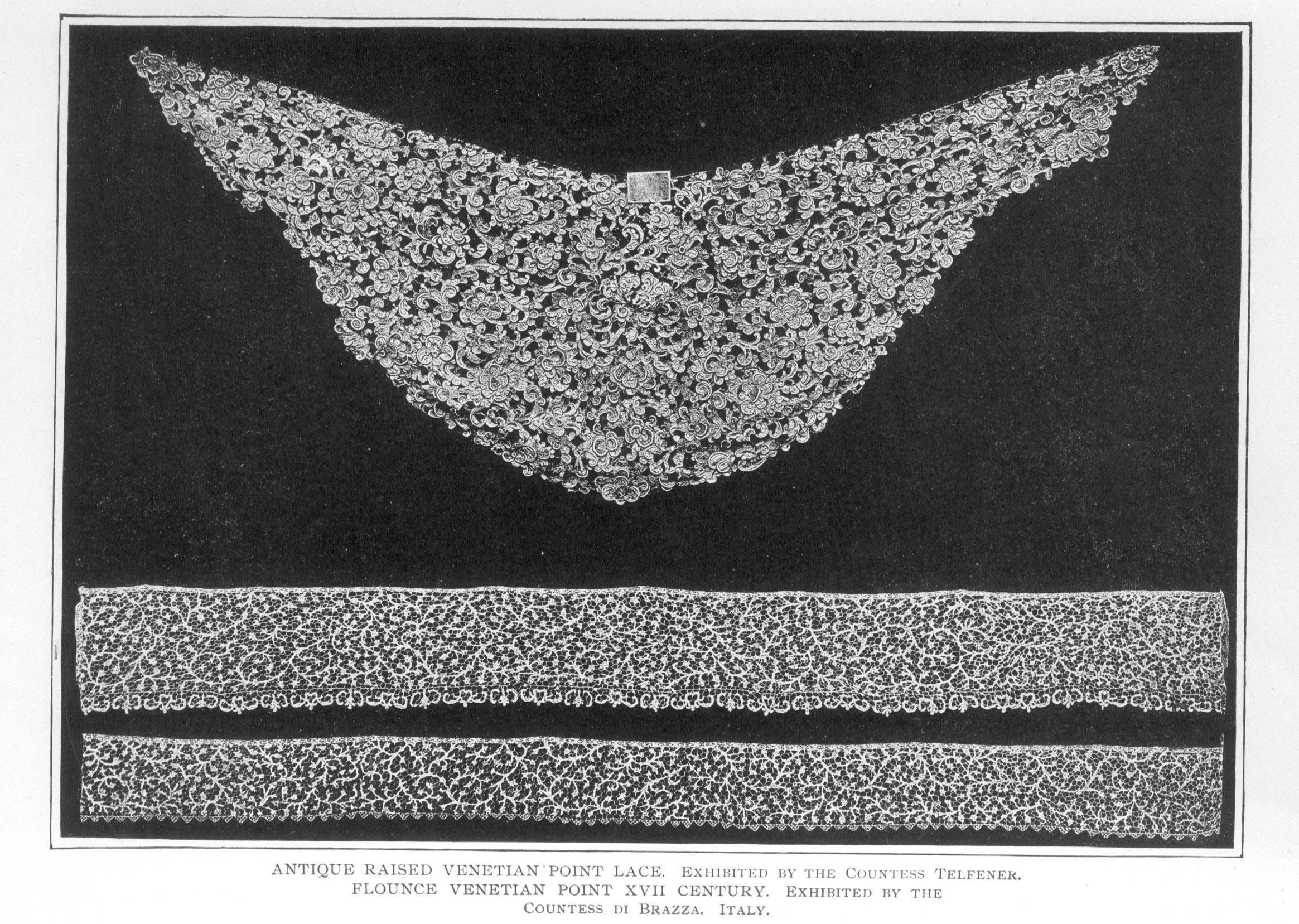
ANTIQUE RAISED VENETIAN POINT LACE.
EXHIBITED BY THE COUNTESS TELFENER.
FLOUNCE VENETIAN POINT XVII CENTURY.
EXHIBITED BY THE COUNTESS DI BRAZZA. ITALY.
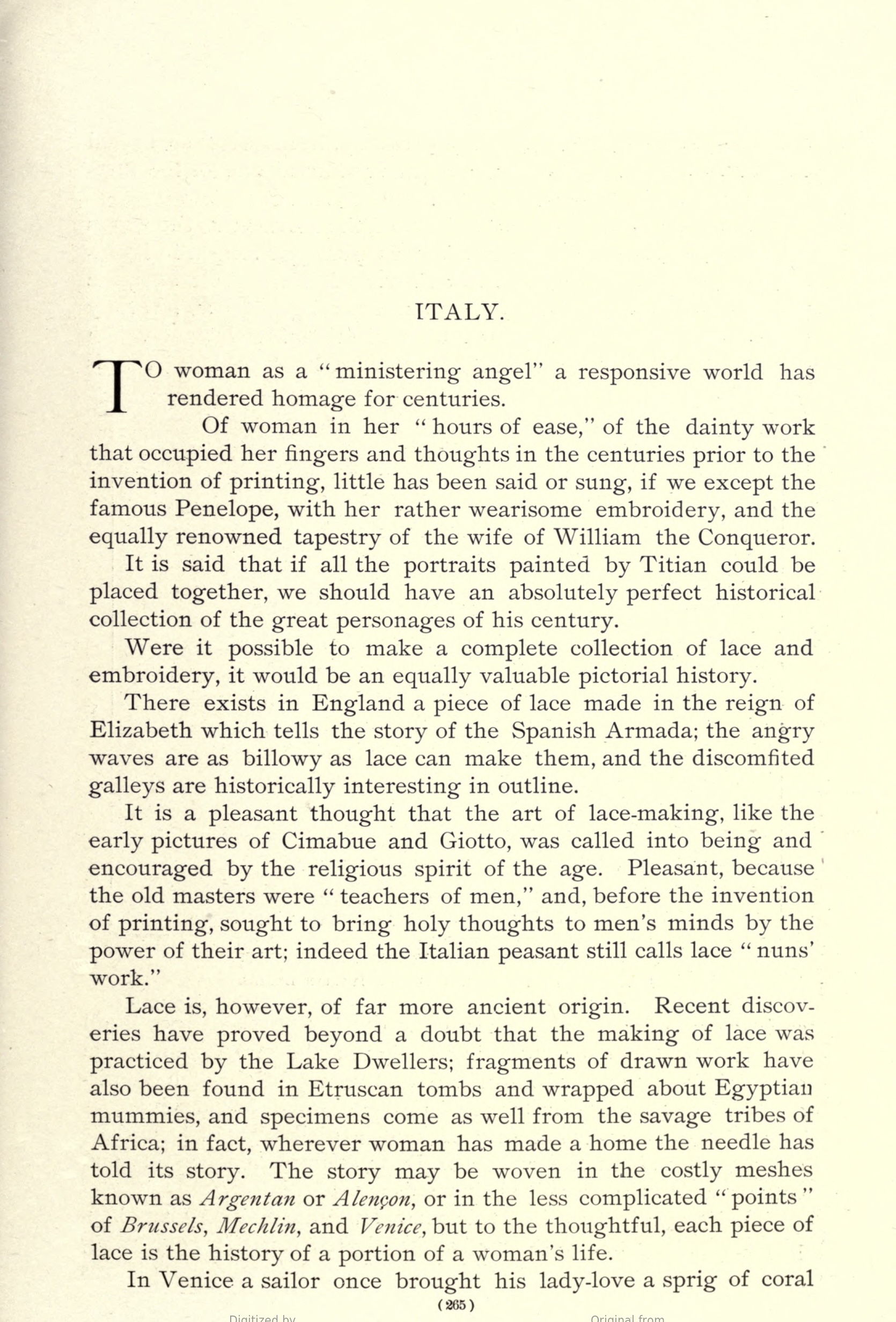
ITALY.
TO woman as a "ministering angel" a responsive world has rendered homage for centuries.
Of woman in her "hours of ease," of the dainty work that occupied her fingers and thoughts in the centuries prior to the invention of printing, little has been said or sung, if we except the famous Penelope, with her rather wearisome embroidery, and the equally renowned tapestry of the wife of William the Conqueror.
It is said that if all the portraits painted by Titian could be placed together, we should have an absolutely perfect historical collection of the great personages of his century.
Were it possible to make a complete collection of lace and embroidery, it would be an equally valuable pictorial history.
There exists in England a piece of lace made in the reign of Elizabeth which tells the story of the Spanish Armada; the angry waves are as billowy as lace can make them, and the discomfited galleys are historically interesting in outline.
It is a pleasant thought that the art of lace-making, like the early pictures of Cimabue and Giotto, was called into being and encouraged by the religious spirit of the age. Pleasant, because the old masters were "teachers of men," and, before the invention of printing, sought to bring holy thoughts to men's minds by the power of their art; indeed the Italian peasant still calls lace "nuns' work."
Lace is, however, of far more ancient origin. Recent discoveries have proved beyond a doubt that the making of lace was practiced by the Lake Dwellers; fragments of drawn work have also been found in Etruscan tombs and wrapped about Egyptian mummies, and specimens come as well from the savage tribes of Africa; in fact, wherever woman has made a home the needle has told its story. The story may be woven in the costly meshes known as Argentan or Alençon, or in the less complicated "points" of Brussels, Mechlin, and Venice, but to the thoughtful, each piece of lace is the history of a portion of a woman's life.
In Venice a sailor once brought his lady-love a sprig of coral
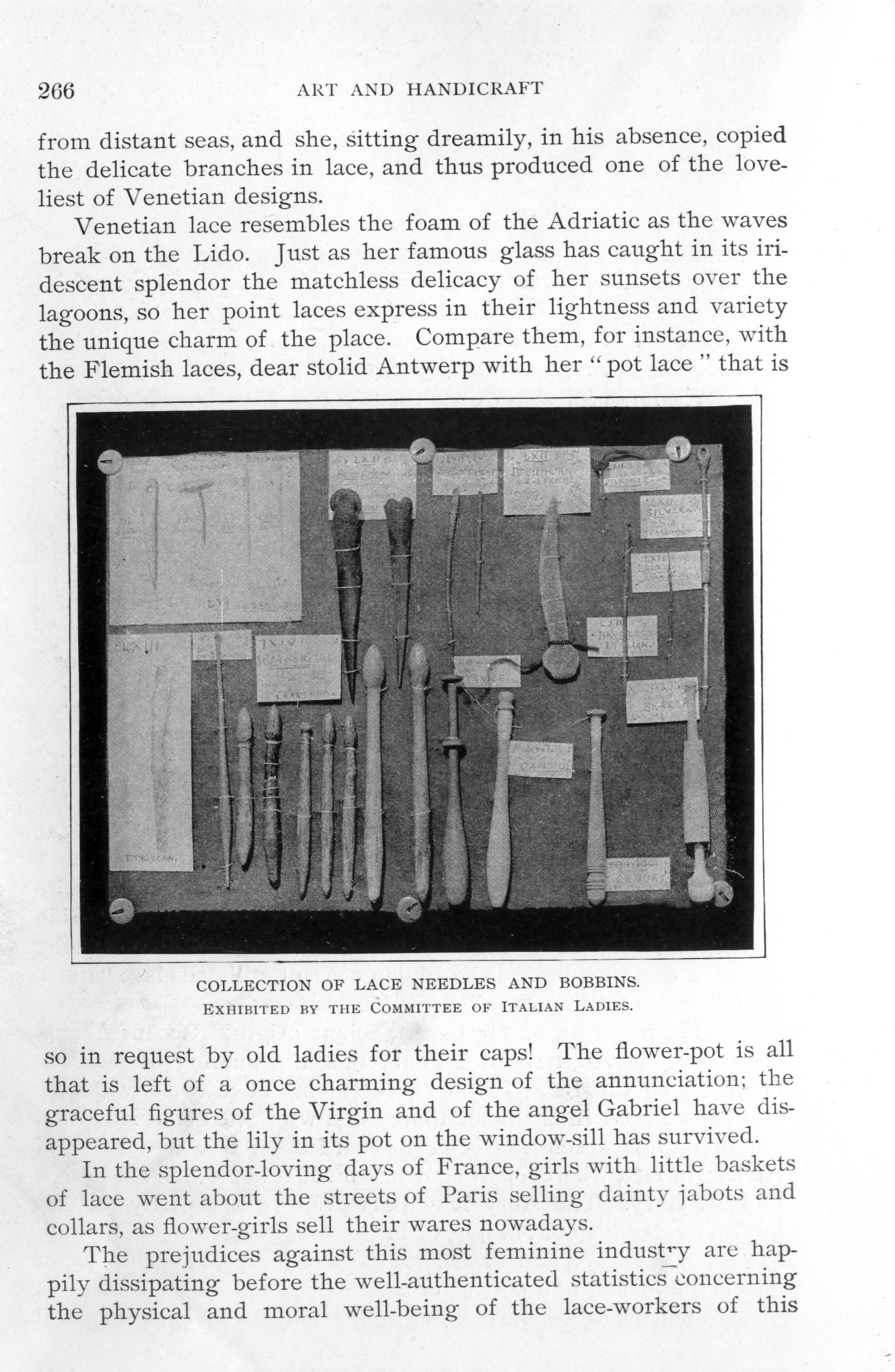
COLLECTION OF LACE NEEDLES AND BOBBINS.
EXHIBITED BY THE COMMITTEE OF ITALIAN LADIES.
from distant seas, and she, sitting dreamily, in his absence, copied the delicate branches in lace, and thus produced one of the loveliest of Venetian designs.
Venetian lace resembles the foam of the Adriatic as the waves break on the Lido. Just as her famous glass has caught in its iridescent splendor the matchless delicacy of her sunsets over the lagoons, so her point laces express in their lightness and variety the unique charm of the place. Compare them, for instance, with the Flemish laces, dear stolid Antwerp with her "pot lace" that is so in request by old ladies for their caps! The flower-pot is all that is left of a once charming design of the annunciation; the graceful figures of the Virgin and of the angel Gabriel have disappeared, but the lily in its pot on the window-sill has survived.
In the splendor-loving days of France, girls with little baskets of lace went about the streets of Paris selling dainty jabots and collars, as flower-girls sell their wares nowadays.
The prejudices against this most feminine industry are happily dissipating before the well-authenticated statistics concerning the physical and moral well-being of the lace-workers of this
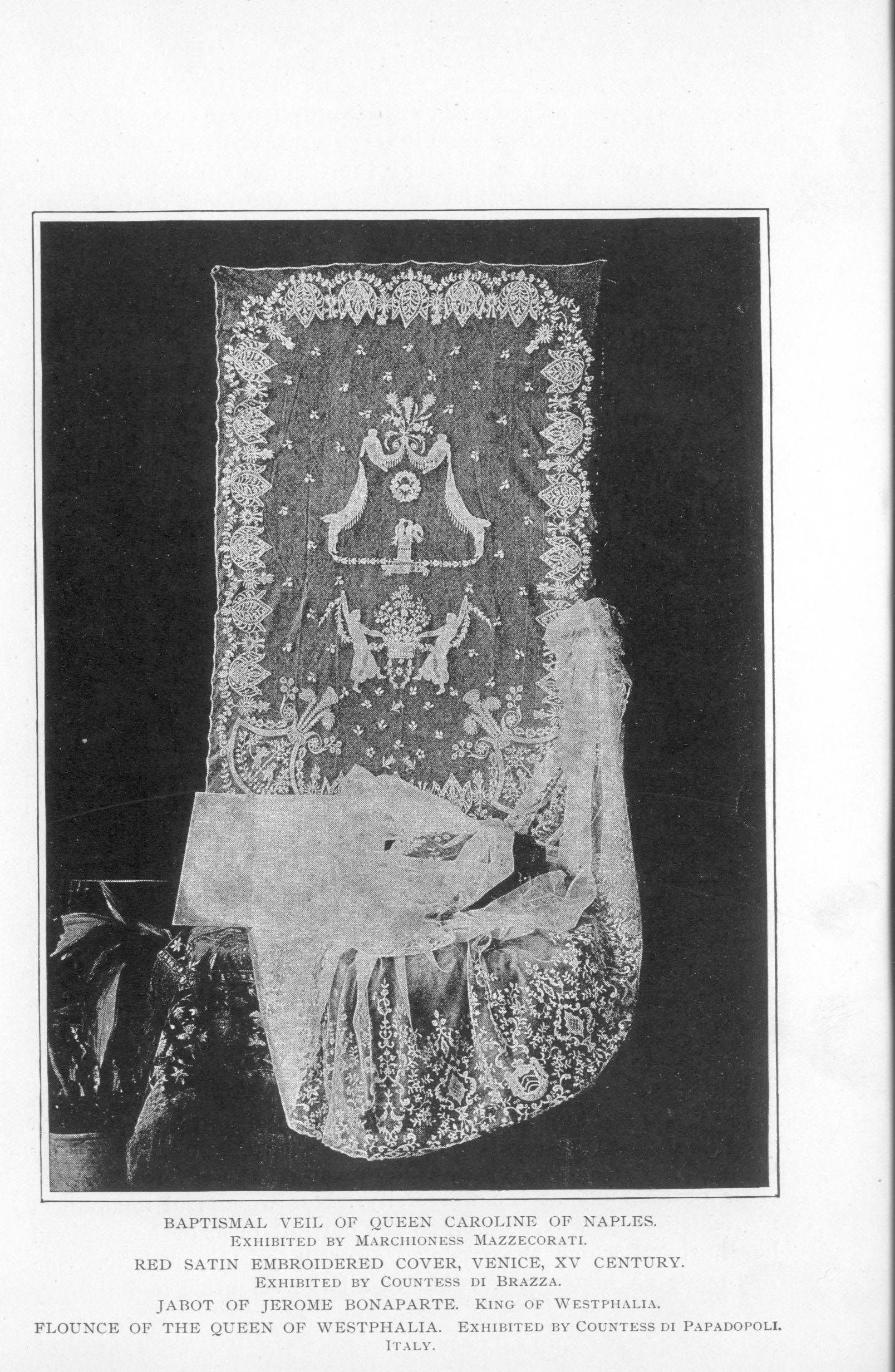
BAPTISMAL VEIL OF QUEEN CAROLINE OF NAPLES.
EXHIBITED BY MARCHIONESS MAZZECORATI.
RED SATIN EMBROIDERED COVER, VENICE, XV CENTURY.
EXHIBITED BY COUNTESS DI BRAZZA.
JABOT OF JEROME BONAPARTE. KING OF WESTPHALIA.
FLOUNCE OF THE QUEEN OF WESTPHALIA.
EXHIBITED BY COUNTESS DI PAPADOPOLI.
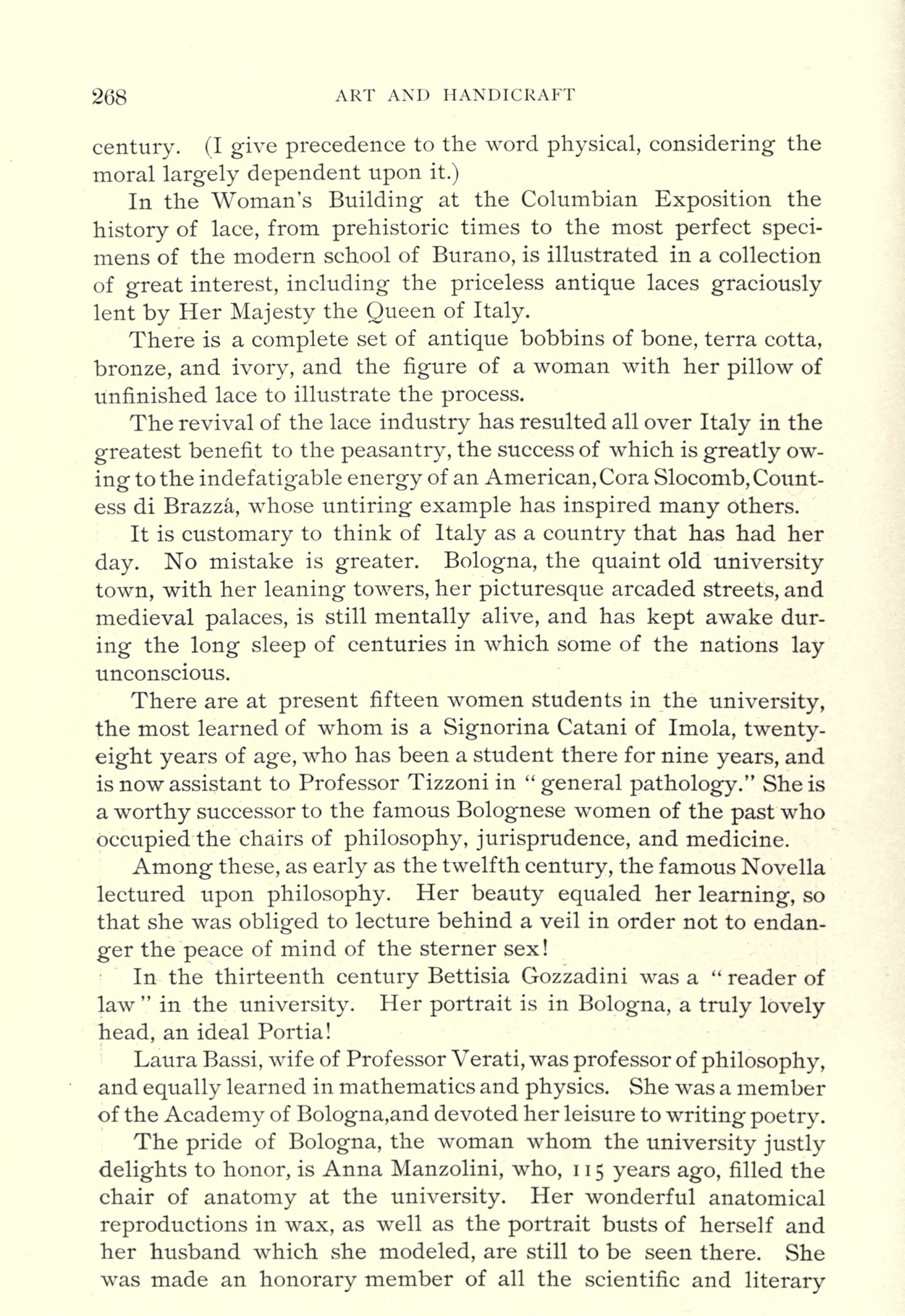
century. (I give precedence to the word physical, considering the moral largely dependent upon it.)
In the Woman's Building at the Columbian Exposition the history of lace, from prehistoric times to the most perfect specimens of the modern school of Burano, is illustrated in a collection of great interest, including the priceless antique laces graciously lent by Her Majesty the Queen of Italy.
There is a complete set of antique bobbins of bone, terra cotta, bronze, and ivory, and the figure of a woman with her pillow of unfinished lace to illustrate the process.
The revival of the lace industry has resulted all over Italy in the greatest benefit to the peasantry, the success of which is greatly owing to the indefatigable energy of an American, Cora Slocomb, Countess di Brazzá, whose untiring example has inspired many others.
It is customary to think of Italy as a country that has had her day. No mistake is greater. Bologna, the quaint old university town, with her leaning towers, her picturesque arcaded streets, and medieval palaces, is still mentally alive, and has kept awake during the long sleep of centuries in which some of the nations lay unconscious.
There are at present fifteen women students in the university, the most learned of whom is a Signorina Catani of Imola, twenty-eight years of age, who has been a student there for nine years, and is now assistant to Professor Tizzoni in "general pathology." She is a worthy successor to the famous Bolognese women of the past who occupied the chairs of philosophy, jurisprudence, and medicine.
Among these, as early as the twelfth century, the famous Novella lectured upon philosophy. Her beauty equaled her learning, so that she was obliged to lecture behind a veil in order not to endanger the peace of mind of the sterner sex!
In the thirteenth century Bettisia Gozzadini was a "reader of law" in the university. Her portrait is in Bologna, a truly lovely head, an ideal Portia!
Laura Bassi, wife of Professor Verati, was professor of philosophy, and equally learned in mathematics and physics. She was a member of the Academy of Bologna, and devoted her leisure to writing poetry.
The pride of Bologna, the woman whom the university justly delights to honor, is Anna Manzolini, who, 115 years ago, filled the chair of anatomy at the university. Her wonderful anatomical reproductions in wax, as well as the portrait busts of herself and her husband which she modeled, are still to be seen there. She was made an honorary member of all the scientific and literary

MACRAME TOWELS.
MODERN AND ANCIENT DESIGNS.
THE EVOLUTION OF MACRAME FROM
SIMPLE KNOTS TO FINE LACE. ITALY.
academies of Europe, and offered professorships in Milan, London, and St. Petersburg, but she never left Bologna.
The famous Clotilde Tambroni filled the Greek professorship at the university at the beginning of this century, and is naively described by her Italian biographer as "singularly modest in voice, gestures, and dress, even at the height of her glory." The future of Italy is as full of hope as her past is rich in example, and under the stimulating influence of Margherita di Savoia, not merely "Queen of Italy," but intellectually the highest lady in the land, the future of woman grows daily brighter
EVA MARIOTTI.
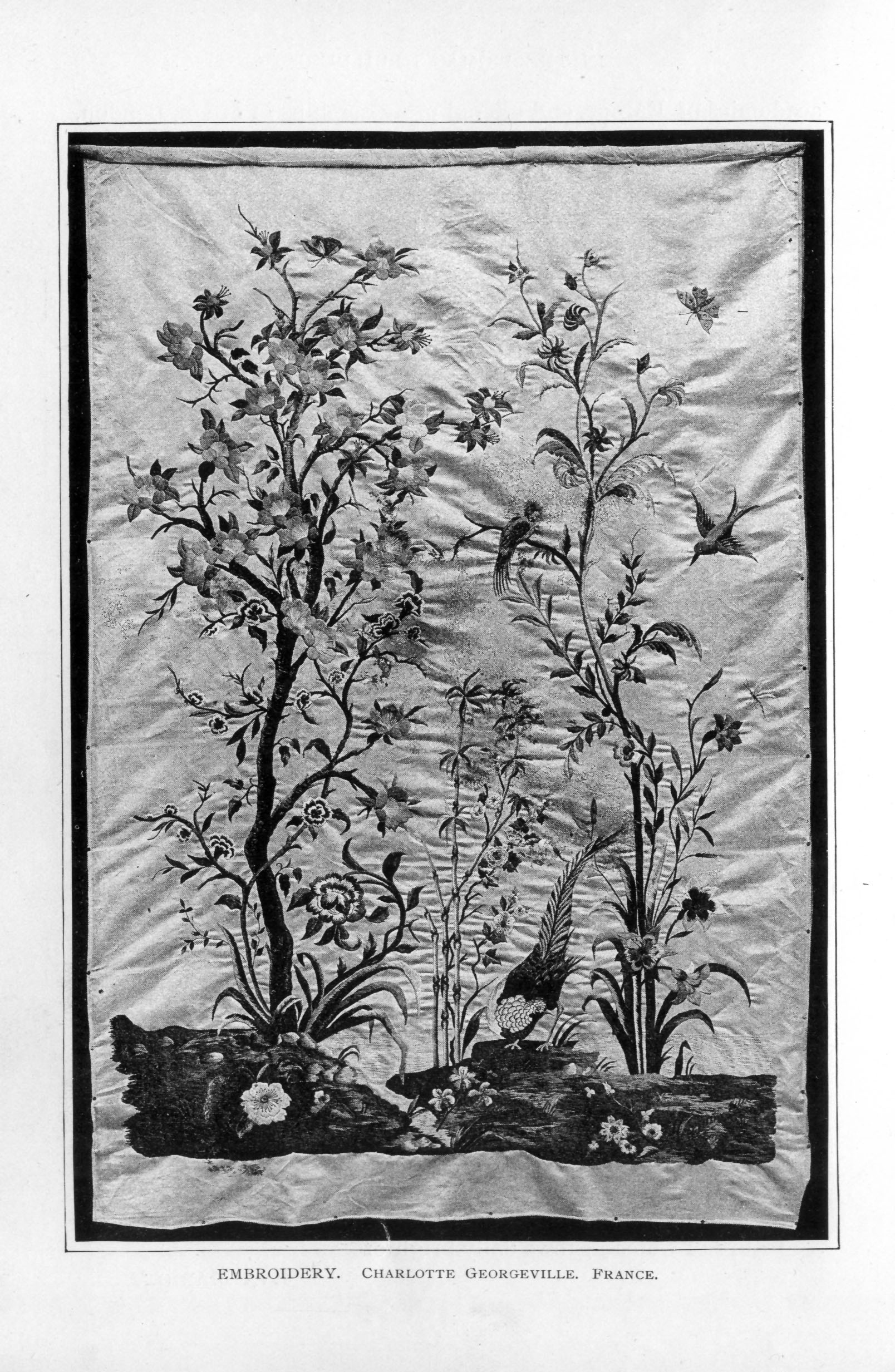
EMBROIDERY.
CHARLOTTE GEORGEVILLE.
FRANCE.